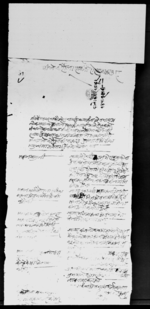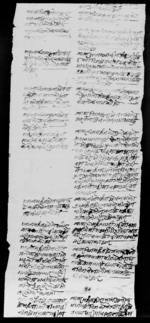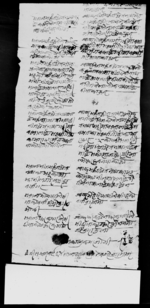A bakapatra supplied by Kālu Jogī Kavara re Mahanta Chetranātha's abbatial succession in Rānagāũ (VS 1964)
ID: K_0469_0038
Edited and
translated by Christof Zotter
Created: 2018-09-14;
Last modified: 2018-12-04
For the metadata of the document, click here
The accompanying edition, translation/synopsis and/or commentary are available under the terms of the Creative Commons Attribution-ShareAlike 4.0 International License
Abstract
In this statement, made in front of Lieutenant Colonel Vīra Bahādūra Basynāt Kṣetrī of the Salyan district office (gauḍā), Kālu Jogī Kavara answers questions regarding the abbotship of Mahanta Chetranātha in Rānagāũ, Salyan.Diplomatic edition
[1r-part1]
1श्री•ले•कर्णेलरणवीक्रंराणावहादुर2\⟪139⟫[seal]1दःलेःकवीरवहादूर
2वस्न्यात्क्षत्री¯ ¯¯1जील्ल्यैसल्ल्याना•मौज्येरानागाऊकामहंत•छेत्रनाथ•प्र
2लोकभयाकोहुनालेस्वमहंत्याञीमामेरोहकहो•
3भंन्यालोकनाथका•वीन्तीपत्र•मालेषीयाका•साछी
4रानागाऊवस्न्या•कालुजोगीकव़रलेसल्ल्यानागौ
5डाका•ले•कर्णैलवीरवाहादुरवस्न्यात•छेत्रीका
6सामुन्यमा•धर्मसम्झीवकेकोवक्पत्र¯¯ ¯¯¯¯
[table1-part1]
| 1 | सव़ालमामुली¯¯¯¯¯¯¯ | ज्वाफमेरोनाऊकालु•मेरावावुकोना ऊवीश्वनाथ•जातकव़रजोगी•घर रानागाऊ•पेसा•षेतीगर्छु•दर्ताके हीछैनवर्ष४९कोभञा•निजम हन्तहरूसंगलीनदीन•ईवीलागस्मे तकेहीछैन¯¯¯¯¯¯¯¯¯¯¯¯¯ |
| 2 | सव़ालस्वमौजे•रानगाऊका महन्तछेत्रनाथलाईची• न्छौकी¯¯¯¯¯¯¯ | ज्वाफरानगाऊकामहन्तछेत्रना थथीयोनिजछेत्रनाथ•येही६४साल ज्येष्टमैन्हाका१७गतेका• दीनप्रलोकभयाछैनं¯¯¯¯¯¯¯¯¯ |
| 3 | सवालनिजप्रलोकहुन्या• महन्तछेत्रनाथकोचे ला•पनीकोहीछंकी¯¯¯¯ | ज्वाफ्नीजमहन्तछेत्रनाथको चेलालोकनाथछन्¯¯¯¯¯¯¯¯¯ |
| 4 | सवालनीजलोकनाथकती वर्षकाछं¯¯¯¯¯¯¯¯¯¯¯¯¯¯¯ | ज्वाफ्नीजलोकनाथजन्मेकोसाल मैन्हाकोथाहाछैनअंदाजीलेवर्ष १२कोनीजलोकनाथकोउमेरभ याकोछ¯¯¯¯¯¯¯¯¯ |
[1r-part2]
[table1-part2]
| 1 | सव़ालनीजमहन्तछेत्रना थलेनीजलोकनाथलाईकैल्हेदेषीचेलोवनाया कोहो¯¯¯¯ | ज्वाफ्सालमजान्दीन•अंदाजीवर्ष ६भयोनिजछत्रनाथ•दाङ्चौघेरा मापीरवस्दानीजलोकनाथकावा वुआमावाटत्याग•चुकाई•नीजछ त्रनाथलेनीजलोकनाथलाई चे लावनायाकोहो•¯¯¯¯¯¯¯¯ |
| 2 | सव़ाल•नीजमहन्तछेत्रना थप्रलोकभयाकोहुँना ले•सोमहंत्याञीकोहक् कस्कोहो¯¯ ¯¯¯¯ | ज्वाफमहंन्तछेत्रनाथ•पर्लोकभया कोहुँनाले•सोमहंत्याञीकोहक नीजलोकनाथ•कोहो¯¯¯ ¯¯¯ |
| 3 | सव़ाल•नीजमहन्तछेत्र नाथकोअरुचेलापनी• कोहीछंकी¯¯¯¯¯¯¯¯ | ज्वाफ्निजमहन्तछेत्रनाथको अरुचेलाछैनंलोकनाथमात्रहुं |
| 4 | सव़ालमहंत्याञीहुन्दा• सावीकदरसावीकमा• केकेकस्वगरीआयाकोछ | ज्वाफ्नीजमहंतकोप्रलोकहुने अवस्ताभयापछी•चेलालोकनाथ लेसोद्धानिजछेत्रनाथलेचेलाको पाषुरासमाई•पीठ्माधाधाप्ल गाई•दी•मेरोसेषपछीमहंतभै वस्नु•भनीभंन्या•काहुन्तेती भै•निजमहंन्तप्रलोकभयाका हुन्•प्रलोकभयापछी•गरीआया वमोजींकाजकृया•गरी•चेलाले महंन्तभै•गद्दीमा•वस्नागरीआ याकाछन्¯¯¯¯¯¯¯¯¯ |
| 5 | सव़ालमहंतछेत्रनाथला ई•कस्लेचेलावनाईमहं त्याञीदीयाकोहों•¯¯¯ | ज्वाफनीजमहंत•छेत्रनाथको गुरुमहंतहीरानाथलेनीजछेत्र नाथलाईचेलावनाई•महंत्या ञीपाऊनेगरी•राषेकाहुन्¯¯ |
| 6 | सव़ालमहंतहुनेले•सकार• मावक्साई•गद्दीमावस्ने गरीआयाकोछकीआफैव सीआयाकोछ¯¯¯ | ज्वाफसोमहंत्याञी•गद्दीमावस्ता अघीदेषी•सल्ल्यांगौडाका•भारा दारसंग•वक्साई•गद्दीमावस्न्या गरीआयाकाछन्¯¯¯¯¯¯¯¯¯¯ |
| 7 | सव़ाल•महंतछेत्रनाथ• प्रलोकहुन्यावषत्मासो मठ्कोकांतीमीलेगर्नु भनी•नीजछेत्रनाथले मलाईअषत्यार•गरीदी याकोछभनी•देवीनाथ जीलेऊजुरगरेकोछसो कुराहोकीकस्वहो ¯¯¯¯ | ज्वाफ्निजमहंतछेत्रनाथप्रलो कहुन्यावषत्मानीजदेवीनाथ लाई•अषत्यारी•दीयाकोहोई ननिजचेलालोकनाथलाई• दीयाकाहुंन्¯¯ ¯¯¯¯¯¯¯¯ |
[1r-part3]
[table1-part3]
| 1 | सव़ाल•महंतछेत्रनाथला ई•महंत्याञी•दीयापछी नीजछेत्रनाथ•गद्दीमा वस्नालाई•सल्ल्यांगौडा काभारादारसंग•वक्सा याकोथीयोथीयेन ¯ ¯¯ | ज्वाफ्महंतहीरानाथ•प्रलोक भयापछीनिजकोचेलामहंतछे त्रनाथ•गद्दीमावस्नालाई•ऊस वषत•कासल्ल्यांगौडाका•भा रादार¯ \ ¯कोपनीसव़ारीभै गद्दीमानिजछेत्रनाथलाईव साई•सर्कारमाजाहेरगरी•ला ल्मोहरहुनगयाकोहो¯¯ |
| 2 | सव़ाल•नीजमहंतछेत्र• नाथका•मठ्कोआ म्दानीलगत्कतीछ वयांगर¯¯¯¯¯¯¯¯ | ज्वाफमहंतछेत्रनाथकामठ कोआम्दानीलगत्मलाईयै तीभंन्यामलाईथाहाछैन |
| 3 | सव़ाल•योमाथीलेषी याकोवयांतीम्रोदुरुस्तभोकी¯¯¯ | ज्वाफ्•मेरोयोमाथीलेषीयाको वयांदुरुस्तभो |
| 4 | सव़ाल•फरकपारीलेषी दीयाकोठहरेतीम्रोकस्वहो | ज्वाफ्फरकछैनफरकपारीले षीदीयाकोठहरेऐनवमो जींवुझाऊला¯ ¯¯¯¯¯¯¯ |
7[?]जकालुकभरजोगी¯¯¯¯¯१
8ईतीसम्वत्१९६४साल्श्रावणगते१०रोज५शुभ्म्¯¯1 [fingerprint] 1दःले•कः
2सही
Translation
[1r-part1]
Venerable L[ieutenant] Colonel Raṇavīkraṃ Rāṇā Bahādura
391
[seal]
[signature of] Da.2 L[ieutenant] C[olonel] Vīra Bahādūra Basynāt Kṣatrī - - -
Testimony (bakapatra) given, keeping the dharma in mind, in front of L[ieutenant] Colonel Vīra Bahādura Basynāta Kṣetrī of the Salyan district office (gauḍā) by Kālu Jogī Kavara, a resident of Rānāgāũ [and] witness mentioned (lekhīyāko) in the petition (bintīpatra) from Lokanātha which states "inasmuch as Chetranātha,3 the abbot (mahanta) of Rānāgāũ maujā, Salyan district (jillā), has passed away, the right to the abbotship is [now] mine."4
[table]
| Question: general [introduction] | Answer: My name [is] Kālu; my father's name [is] Vīśvanātha. Caste (jāta): Kavara Jogī. Home: Rānāgāũ. Profession: I do fieldwork. [I] have no registration (dartā). [Age:] 49 years old. I have no business dealings5 with [and also] no ill will towards the said mahantas. | |
| Question: You knew Mahanta Chetranātha of that6 maujā, Rānāgāũ, or not? | Answer: The mahanta of Rānāgāũ was Chetranātha. The said Chetranātha passed away on the 17th solar day (gate) of the month of Jyeṣṭha this year, [VS 19]64. [He is] no more. | |
| Question: Was there also some disciple of the said late Mahanta Chetranātha, or not? | Answer: There was a disciple of the said Mahanta Chetranātha: Lokanātha. | |
| Question: How old is the said Lokanātha? | Answer: The year [and] month of birth of the said Lokanātha I do not know. The said Lokanātha is approximately 12 years old. 7 |
[1r-part2]
[table]
| Question: When did the said Mahanta Chetranātha make the said Lokanātha [his] disciple? | Answer: The year I do not know. It was approximately six years ago.8 When the said Mahanta Chetranātha was residing as head of the monastery (pīra) in DangCaugherā9 [and] the said Lokanātha had already left [his] father [and] mother, the said Chetranātha made the said Lokanātha [his] disciple. | |
| Question: Now that the said Mahanta Chetranātha has passed away, who has the right to the abbotship? | Answer: Now that the the said Mahanta Chetranātha has passed away, the right to the abbotship is Lokanātha's. | |
| Question: There are other disciples of the said Mahanta Chetranātha, or not? | Answer: There are no other disciples of the said Mahanta Chetranātha. There is only Lokanātha. | |
| Question: What all is traditionally done [and] how [is it done] in the customary practice when on one accedes to the abbotship (mahantyāñī hundā)? | Answer: When the said mahanta was about to die, the disciple Lokanātha asked [him a question].10 The said Chetranātha seized the disciple's upper arm, slapped the [disciple's] back [and] said: "After my death be the mahanta [and] occupy [the throne]." That was the extent of it, and the said mahanta passed away. After [he] passed away, the disciple performed the kājakṛyā11 according to what is traditionally practised, became mahanta [and now] occupies the throne. [This is what] is traditionally done. | |
| Question: Who made Mahanta Chetranātha [his] disciple [and] gave [him] the abbotship? | Answer: The guru of the said Mahanta Chetranātha, Mahanta Hīrānātha, made the said Mahanta Chetranātha [his] disciple and appointed him [his successor] so that he would receive the abbotship. | |
| Question: Is it the tradition that a mahanta-to-be occupies the throne after being authorized by the government, or is it rather the tradition that he occupies [it] on his own? | Answer: Once the [one who one who is selected for] the abbotship [is set to] occupy the throne, it is the tradition from earlier times to do so [only] after being authorized by the bhārādāra of the Salyan district office. | |
| Question: Devīnāthajī has submitted a complaint, saying: "When Mahanta Chetranātha was passing away, the said Chetranātha gave me the authority, saying 'You do the work of [overseeing] the maṭha'."12 Is it so, or how is it? | Answer: When the said Mahanta Chetranātha was passing away, the authority was not given to the said Devīnātha. [It] was given to the said disciple Lokanātha. |
[1r-part3]
[table]
| Question: After Chetranātha was given the abbotship (by his guru), was the said Chetranātha authorized to occupy the throne by the bhārādāra of the Salyan district office, or not? | Answer: After Mahanta Hīrānātha passed away, in order for his (nījako) disciple Chetranātha to [be able to] occupy the throne, the then bhārādāra of the Salyan district office, [venerable L[ieutenant] Colonel Raṇavīkraṃ Rāṇā Bahādūra], 13 came (savārī bhai), installed the said Chetranātha (on the throne), informed the government [and the process of issuing] a lālamohara was initiated. | |
| Question: How much was the said Mahanta Chetranātha's assessment of maṭha's revenue? Declare [the amount]. | Answer: I canot say how much the said Mahanta Chetranātha's assessment of the maṭha's revenue was. | |
| Question: The declaration of yours written above is14 the exact truth, or not? | Answer: This declaration of mine written above is15 the exact truth. | |
| Question: If it is proven that [your statement] deviates [from the truth], what will be your [response]? | Answer: There is no deviation. If it is proven that [the statement] was deviates [from the truth], I will pay the price according to the law. |
[The said] Kālu Kavara Jogī16 - - - 1
fingerprint
signature Da.17 L[ieutenant] C[olonel]
Thursday, the 10th solar day (gate) of Śrāvaṇa in the [Vikrama] era year 1964 (1907 CE). Auspiciousness.
Commentary
The document is one of the witness statements18 that were sent from Salyan to Kathmandu in support of a petition by Lokanātha to be recognized as successor to the throne (see K_0469_0033).



